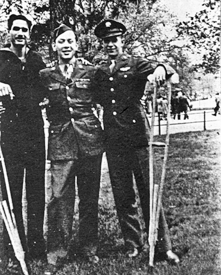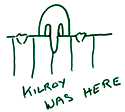The Stamford Historical Society Presents
Pride and Patriotism: Stamford’s Role in World War II
Online Edition
The Interviews
Dan Roberts
Dan Roberts went through the Army Specialized Training Program until it was cancelled because of the need for bodies to carry out the invasion of Europe. He joined the 104th Infantry as a replacement soldier. He had several close calls before he was wounded by a mine in Germany.
 I was graduated from Brooklyn Technical High School. Then I worked in Brooklyn Navy Yard as a draftsman. I qualified for Army Specialized Training Program. Put into ASTP, the object was to send guys to college to learn disciplines, then go to Officers Candidate School and then go to World War II.
I was graduated from Brooklyn Technical High School. Then I worked in Brooklyn Navy Yard as a draftsman. I qualified for Army Specialized Training Program. Put into ASTP, the object was to send guys to college to learn disciplines, then go to Officers Candidate School and then go to World War II.
I had Basic Infantry training at Fort Benning, Georgia. It was a hot summer ‘43…Basic Training lasted four weeks, then I was assigned to college. I went to Princeton…lived in Brooklyn, to study engineering, this was in January 1944. I had been at Princeton for three months, but we were preparing for June 6 D-Day …lots of bodies were needed, so they cancelled ASTP and we were assigned to an infantry division…most guys were young, 18/19 right out of high school.
I was then assigned to the infantry at Camp Carson, Colorado with the 104th Infantry Division. We were called the Timberwolves…the patch on the arm shoulder…green patch with timber wolf head.
By April of 1944 I was a private in an infantry squad. I was trained how to shoot gun, throw grenade, make it through obstacle course...exercises every morning…first aid, discipline. My gun was an M1 rifle.
In August 1944 we were on a long troop train from Colorado to New Jersey to embark…got on boat to Europe. We didn’t know our destination, just Europe. It was a huge convoy…largest that went across, hundreds to thousands in the boat. Navy destroyers accompany you…you got a knapsack that’s it.
We landed in Cherbourg, France first, a supply port, our regiment landed on Utah Beach…we saw the rusting hulks of tanks, rubble, no bodies…remains of Utah Beach , tank traps…Then we went right inland to bivouac…open tents etc.
It was September 8 when we landed…nice weather. The battalion then broke up…drivers were assigned to trucks, Red Ball Express, to bring supplies up to front lines by truck. At that point the Army was moving fast into Germany…
I was sent to guard supply trains outside of Cherbourg…we took trains into Paris depot…the squad leader was a sergeant and we wanted to see Paris…there were blackout restrictions…we found a USO…met a lady who invited us to dinner. The next morning we took the freight train back to division Utah Beach, then were transported by truck to Belgium. We had to walk a lot at night. We had still seen no action, just results.
The Division joined the Canadian Army there with the object to open up the port of Antwerp as second supply port…we were attached temporarily to the Canadian Army…Terry Allen was Brigadier General of this Division.
We got off the trucks with our rifles and into the war. First experience I had – I was almost killed three times – I stopped by a farm outside a village, Oudenbosch, Holland… We were digging foxholes, that’s the first thing you do…we piled dirt between us… a huge explosion occurred that knocked us down. I couldn’t hear for a while…It was either a short round of friendly fire, or a German 88mm gun tank shell.
It was close…just one shell, no other firing just one stray shell. Next day we walked through a village…as we walked people came out with flowers, candy, chocolate, food and flags…still had seen no Germans…they were hard to find.
That night I dug another foxhole before action…it was raining and muddy, in the foxholes it was wet…we had heavy winter coats on…so I wanted to find something to cover my foxhole to keep the rain out…I climbed over to a fence, and with my shovel hit the fence to break off wood, a machine gun went right off near my ear, I fled back to the muddy foxhole.
We proceeded forward and had to cross a stream, Holland has lots of dykes, there was a stream next to the dyke and we waited while engineering brought up metal boats. As we were crossing, machine gun bullets went down stream. They missed us. Then we climbed up the dyke and then in battle.
We had no communication with home…special forms for everything and mail was all edited. They censored mail.
We were attacked along the dyke. I captured a German…We took his pistols, armband,s etc. for souvenirs. Soon Antwerp open and again men were put on trucks…not too much fighting on the dyke…and we didn’t see the Germans just stray bullets.
We were put on trucks and the Division moved into Germany. Things got going. The Siegfried Line was a long line of anti-tank concrete barriers to keep U.S. tanks out. We got through the line and spent the first night in a German bunker on guard duty…there was no resistance yet. We marched until the battalion was to capture the city of Stolberg Germany, a small industrial town.
We were walking down the main road, alongside was a depression with a track, on the other side was woods. Our squad took us into woods. We sat down for a while…It was November 18th, 1944, and then our Sergeant gave each man a satchel charge – a burlap wrapped box…rectangular/square box a few inches thick packed with explosive because ahead of us was a German bunker with German in it…the object was to blow up the bunker and get out of the way.
As we crawled up to the bunker, in a depression we could look down. The sergeant ordered us to back up, because Germans were about in the woods, then Sergeant Allen was shot. Someone had to find a medic. I ran back to try to find a medic. I got out of the woods, went down and through the trolley track and saw a Jeep. I yelled to stop and asked “Where are the medics?” I hopped in and they took me to the medics in an old farmhouse. It was late November and was dark out by 4:30PM, too dark when I reached medics, and no lights permitted, too dark…medics refused to go back at night. I slept on floor of the aide station overnight. I told them where the problem was. I walked back across road into woods to find my squad, and as I was walking down path in woods there was an explosion. I had stepped on anti personnel mine. The area was full of mines. I had trauma after stepping on the mine, I was on my back…I saw a shallow black hole…it was a schu-mine – a small square box one inch thick with cover slightly open. The box was buried just under surface and covered over. It exploded when stepped on...would take off a leg. I had stepped on the edge of the box… I got a piece in the hand, another went through my right leg and cut an nerve and broke muscle sheath of left leg…I crawled out and yelled for medics and they came running and gave me morphine. Every infantryman has packet of sulfonamide powder antibiotic…stop infection. They put me on a Jeep, and went back to the battalion aide station on a stretcher. The Doctor looks at you, tags you, then I was put on a hospital train to Paris.
I had a bunk on the train. I got a shot of penicillin. They took the shrapnel out in an Army hospital in Paris. I wrote a letter home – dictated to a friend in the ward. I sent the letter to my uncle who had a Ph.D. in chemistry…
After I was sent on a train to the Channel, then on a boat over to England… We landed at Southampton…the train went to an Army hospital in Warrington outside Liverpool, England. It was a quonset hut hospital…a long metal hut, heated by a pot bellied stove…I couldn’t walk. We had a Christmas Party in 1944…party in hospital.
Later I shipped up to a Liverpool hospital ship, then back to the US. There were lots of subs in the North Atlantic…my trip was to Charleston, South Carolina, and a hospital ship is slow moving. We went to the west coast of Africa, then cross to U.S. I took a train to a hospital in Wakeman, Indiana…different hospitals were for different wounds. I had plastic surgery, physical training to walk again and in Nov 1945 Medical discharge with 100% disability.
In Germany we stayed warm by wearing lots of layers. The army gave out overcoat, under-jacket, under-sweater…layered…under-helmet, khaki cap covered ears over chin, helmet liner, gloves…we were often sleeping under the stars, often especially in the woods.
I never had a shower in the field…if there was a rotation there may be a chance for bath but not generally. We also ate C-rations – khaki cans…didn’t taste good, open can, had food. Everyone had cans.
I got one shower in Germany after a night in a bunker…that morning they brought up mess truck, that was it.
I had no contact with my unit again after the mine incident…many divisions had a book written, I got the book from history of landing till the unit disbanded…I did find out that Sgt. Allen had been killed, beyond that I had no contact afterward.
We were only together in battle. ATSP candidates joined 104th. We joined soldiers who did not have lots of education…different background…didn’t mix in…we were not accepted by the others…there was no cameraderie. The squad was more familiar but not friends…
There was constant anxiety...we never saw Germans but knew they were there. The 88s did attack in the foxholes…we did lots of praying…during Antwerp campaign with Canadian army group. But we never saw Germans…we would just shoot in direction of noise. More like a guerilla war.
Some Germans were sent to U.S. POW camps here in US…Texas..
Went through French City, St. Lo, could see bombed out building etc..
Everyone had cigarettes, chocolates…Army scrip…played poker.
Never got into the big cities.
In the bunker we heard planes that flew over to bomb Germany…thousands of planes…hear the drone of planes.
back to top
 Introduction
Introduction
Veterans
Battles
Stamford Service Rolls
Homefront
Exhibit Photos
Opening Day

